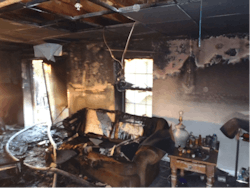In 1987, Prince George’s County, MD, instituted strong smoke alarm legislation, requiring all new homes permitted after 1987 to be built with hard-wired smoke alarms on every floor. The Prince George’s County Fire/EMS Department (PGFD) followed this smoke alarm legislation with residential sprinkler legislation in 1992, becoming the first county in the United States to require both smoke alarms and fire sprinklers in all new construction. Additional legislation has since expanded to carbon monoxide detectors (where applicable) and smoke alarm requirements on all floors and in all sleeping areas in ALL existing residential properties, regardless of age.
Fires and fire fatalities have decreased significantly since 1987, due largely to expanded fire prevention, public education and legislative efforts (community risk reduction or CRR). Even with all those CRR efforts in Prince George's County, including aggressive legislation and enforcement, there have been more than 7,000 residential fires, resulting in 230 fire fatalities and 644 fire-related injuries since 1992. PGFD's major fire problem continues to be small- to medium-size single-family homes and medium-size garden-style, multi-family residential properties.
In 2009, a 15-year report on the Prince George's County experience was completed by Steve Weatherby, in cooperation with the Home Fire Sprinkler Coalition. That report produced an astounding, albeit not unexpected, statistical comparison of fires in sprinkler-protected vs. non-protected structures. It is important to recognize that 96 percent of the injuries and 100 percent of the fatalities noted above occurred in residences where there was NO sprinkler protection. Of the 7,000 residential fires reported above, 667 occurred in sprinkler-protected homes. In each case, sprinklers activated and held the fire in check, resulting in ZERO fire fatalities and approximately 23 injuries. A comprehensive update on this report encompassing 25-years of data will be completed this year.
The near miss
As I write this article (and find my superstitious self knocking on wood), we have just completed the analysis of a different kind of near-miss incident in a sprinkler-protected single-family home in the Jennings Mill community. The home, which was constructed in 1992, is part of a much larger development permitted/built on both sides of the residential-sprinkler requirement date. In this development (as well as many others), neighboring homes on the same street vary in their level of protection, purely based upon the construction permit date.
The two-story colonial-style home, built over a walkout basement, sports residential sprinklers on all floors, including the originally unfinished basement level. The current owners purchased the home from someone who had previously “finished” the basement with living, sleeping and storage space. The house was then rented to the current occupants. At first blush, the basement-finish job looked typical—not flashy, not shabby.
The Jennings Mill community is a quiet residential area on the southern edge of the City of Bowie, about 5 miles east of Interstate 95. On March 7, 2015, a cold, snow-covered Sunday morning, a 9-1-1 call reported a fire in the basement on Jenkins Ridge Road. The second-floor caller reported being awakened by smoke alarms with smoke issuing from the basement. The early smoke alarm notification allowed two adults enough time to exit the home, with an adult resident reported as unaccounted for and presumed trapped in the basement.
First-arriving units reported smoke showing from the home and confirmed the report of one trapped in the basement. Crews stretched an attack line to basement entrance, affected a quick rescue of the occupant and knocked down the fire in the basement, where sprinklers were now flowing. The 61-year-old male occupant suffered second- and third-degree burns over 40 percent of his body. He was flown by Maryland State Police medevac helicopter to the Washington Hospital Center burn unit in critical condition. After months of extensive care and rehabilitation, the victim was released from the hospital in good condition.
How does this happen? Recall from above that in 23 years of sprinkler-protected home fire statistics, only 23 civilian/occupant injuries have been reported with sprinkler-activation incidents, while 621 injuries were reported in non-protected occupancies.
PGFD’s fire investigators quickly noticed some abnormalities with the basement construction finishes. There were two types of finished ceiling in the basement area, including both finished drywall and suspended-track-panel ceiling. Investigators were astounded to find that both of those ceilings were installed BELOW the original construction sprinkler heads, with no provision whatsoever for sprinkler penetration. Fortunately, the suspended ceiling failed fairly quickly during the fire event, which allowed enough heat to activate a sprinkler head. Ultimately, four sprinkler heads would activate, as heat traveled between the ceilings, which then caused the drywall ceiling to fail, allowing water to reach the seat of the fire. This occurred as firefighters were entering the basement with their attack line.
After evaluating the scene and interviewing the occupant at the burn unit, investigators determined that the fire was caused by clothing and combustible materials placed too close to a portable heater. The heater caused the combustibles to ignite, which spread to the couch that the occupant was sleeping on.
Conclusions
New construction and permitting must be closely tied to ensure that proper fire protection measures are in place. The “retrofit” and after-market finishing made by an occupant without permitting is clearly a contributing factor to this fire and its near-tragic outcome. It is imperative that departments and applicable inspectors are fully aware of the relationship among construction, inspection and the functionality of the sprinkler systems. A public education effort may or may not have impacted this construction decision. It is clear, however, that even when the sprinkler functionality was hampered by human intervention, the sprinklers STILL activated, and likely prevented a fire fatality and significant structural loss to this home. Smoke alarms and sprinklers save lives—the evidence is irrefutable—and we must continue to have ZERO TOLERANCE for fire fatalities in sprinkler-protected homes.
About the Author

Marc S. Bashoor
MARC S. BASHOOR joined the fire service in 1981. In 2017, he retired as fire chief of Prince George’s County, MD, Fire/EMS, the largest combination department in North America. His progressive community-based approach led to record hiring and a strategic apparatus replacement plan.
Twitter: @ChiefBashoor
Email: [email protected]
